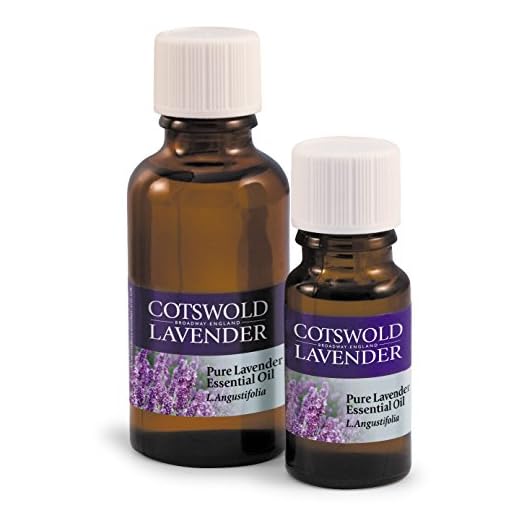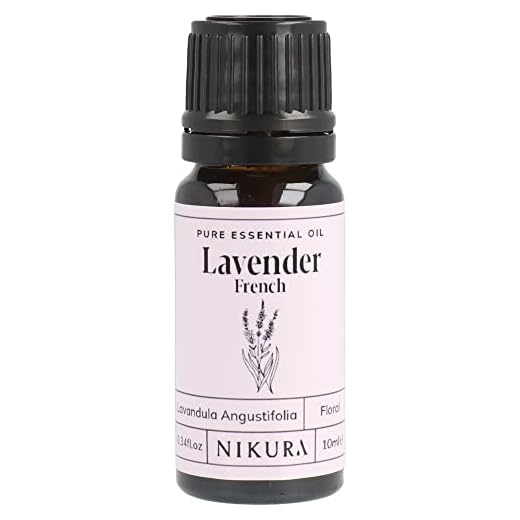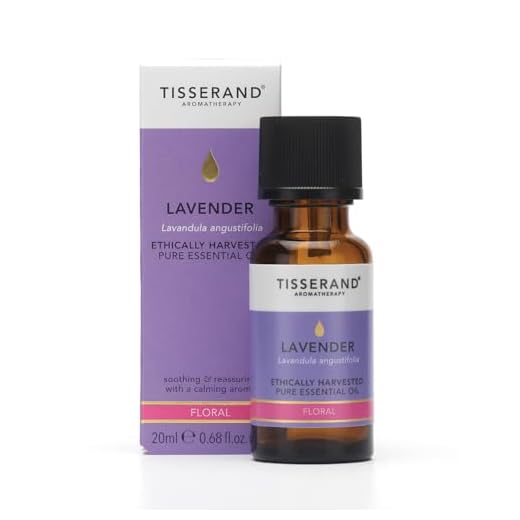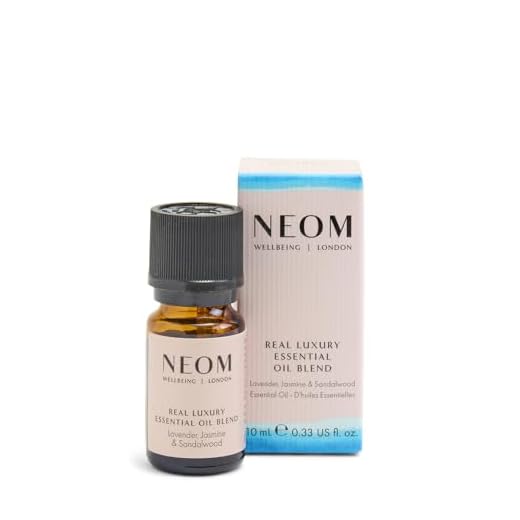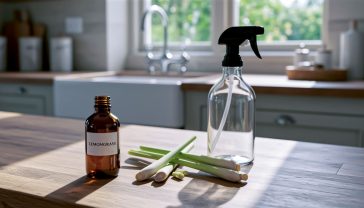Top 4 Lavender Diffusers for Relaxation: The Ultimate British Guide to Choosing the Best
Tired and stressed? This ultimate guide explains every type of lavender diffuser, from ultrasonic to nebulising, to help you find the perfect one for your UK home.
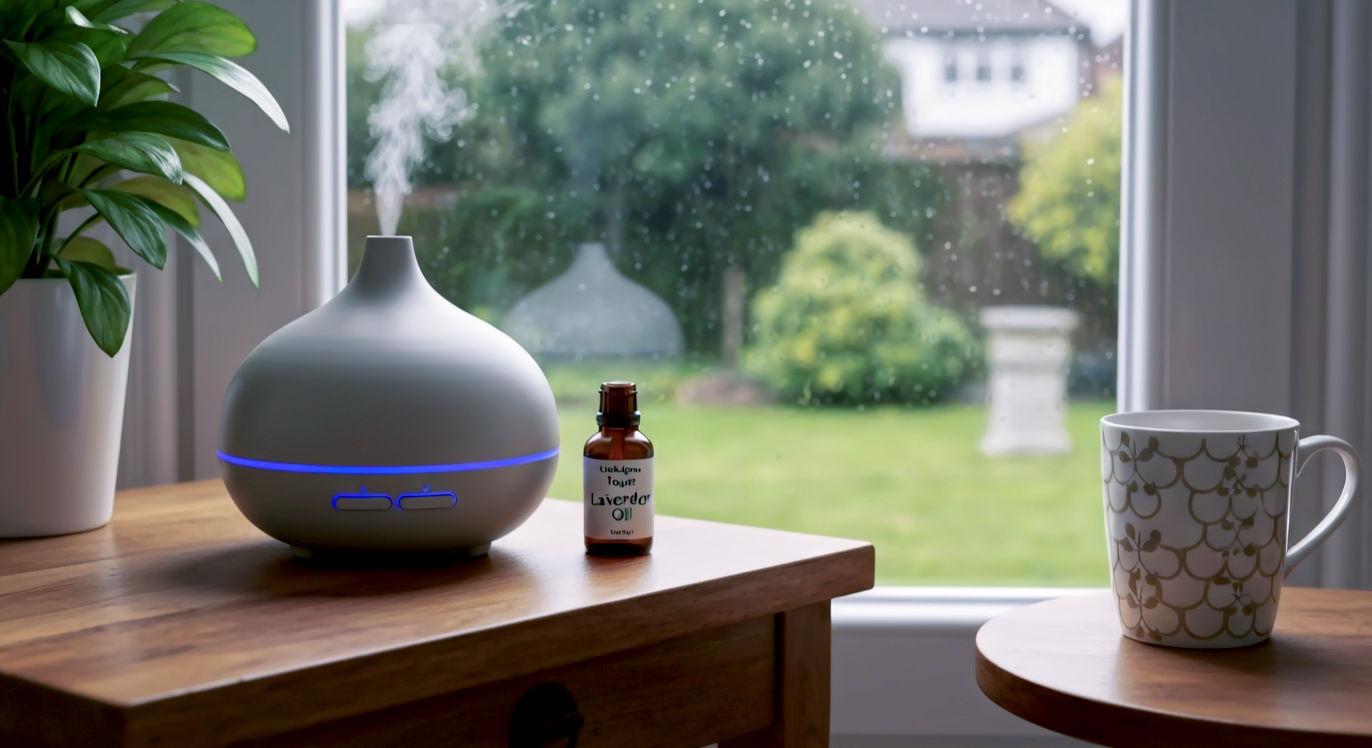
This post may contain affiliate links. If you make a purchase through these links, we may earn a commission at no additional cost to you.
Let’s be honest, modern life in the UK can be a bit… much. Between the never-ending news cycle, the packed commuter trains, and the price of a flat white, finding a moment of genuine peace feels like a victory. We’re all chasing that elusive feeling of ‘calm’. We try mindfulness apps, we go for a run in the drizzle, we perfect our sourdough. But one of the simplest, most ancient solutions is right under our noses.
I’m talking about lavender.
That iconic purple flower you see lining cottage gardens and sprawling across fields in the Cotswolds isn’t just a pretty face. It’s a powerhouse of relaxation. The best way to bring that power into your home is with a lavender diffuser.
But here’s the rub: searching for a “lavender diffuser” online is a digital headache. You’re flooded with thousands of options. Ultrasonic? Nebulising? Do you need one that lights up? Why is one £20 and another £120?
This is where we come in. This is your definitive, no-nonsense guide to finding the perfect lavender diffuser for you. We’re going to cut through the marketing fluff and explain what you actually need to know. We’ll cover everything from the different types of machines to picking the right oil (and spotting the fakes) and, crucially, how to use it safely, especially if you have furry flatmates.
So, make yourself a cuppa, get comfy, and let’s dive into the wonderful-smelling world of lavender diffusers.
Part 1: The Magic of Lavender – Why This Purple Plant?
Before we talk about the gadgets, let’s talk about the main event: the lavender itself. Why are we all so obsessed with this one particular scent?
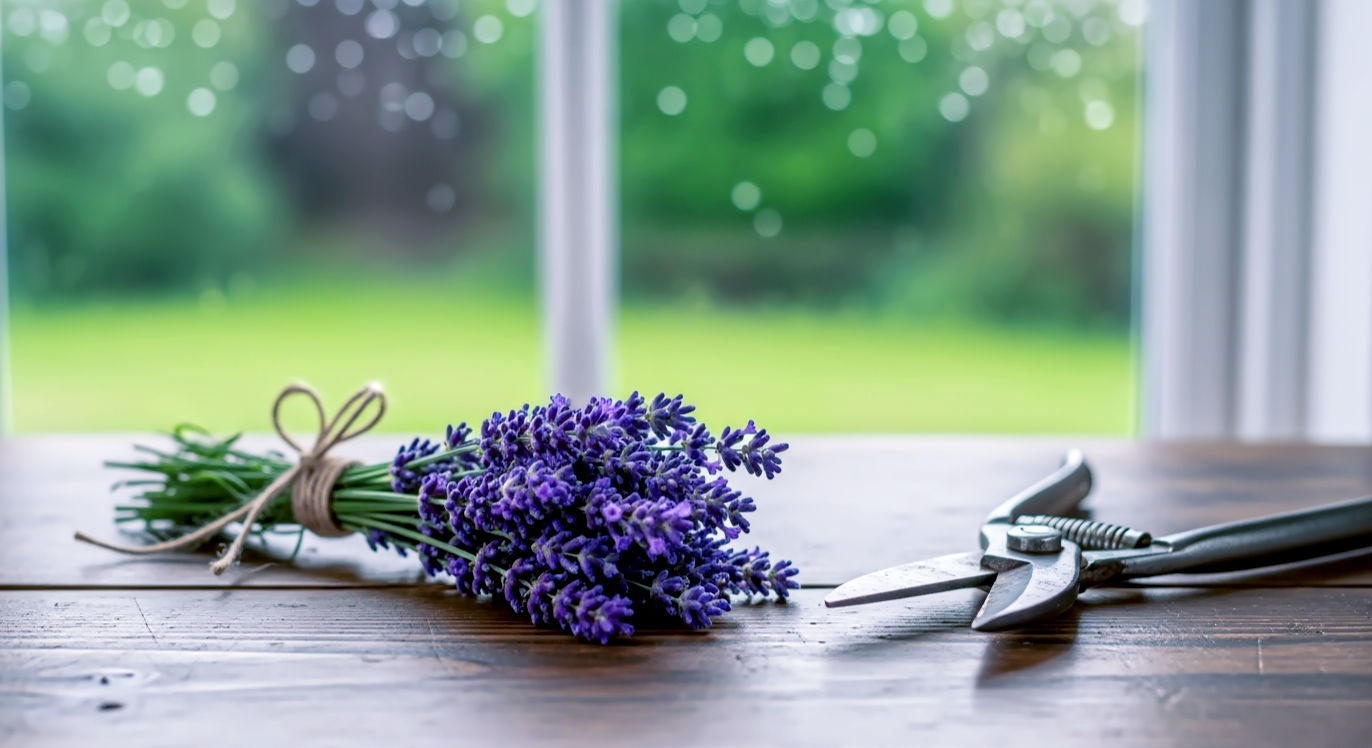
What’s So Special About Lavender? (The Science Bit, Made Simple)
When you crush a lavender flower, you’re releasing its essential oil. This oil is packed with complex natural chemicals. The two most famous ones are linalool and linalyl acetate.
You don’t need to remember the names. All you need to know is that when you inhale them, they get to work on your brain. They’re thought to interact with a brain messenger called GABA (gamma-aminobutyric acid). This is the same system that anti-anxiety medicines work on. In simple terms, these lavender compounds tell your brain’s “panic” button to stand down and your “calm” button to take over.
It’s not magic, it’s just very clever plant chemistry that our bodies happen to understand.
A Whiff of History: Lavender in Britain
Lavender is practically woven into the fabric of Britain. We might not have invented it (the Romans brought it over to perfume their baths), but we certainly adopted it.
- Tudor Times: Queen Elizabeth I was a huge fan. She reportedly drank lavender tea to help her migraines and demanded fresh lavender in her vases every single day.
- Victorian Era: This is when it really boomed. Lavender “wands” (bundles of fresh lavender tied with ribbon) were tucked into linen drawers all over the country to keep things smelling sweet and repel moths. Little bags of dried lavender, or ‘potpourri’, were in every respectable sitting room.
- Modern Day: Today, lavender is big business. You can visit stunning lavender farms from Kent to Norfolk to the Cotswolds (Cotswold Lavender near Snowshill is a famous one). It’s gone from a garden herb to a major player in the UK wellness industry.
Not Just a Pretty Scent: The Proven Benefits
This isn’t just old wives’ tales. Modern science is catching up with what our grans always knew. While we can’t (and shouldn’t) claim it “cures” anything, studies have shown that lavender’s aroma can:
- Help You Nod Off: Inhaling lavender before bed has been shown to improve sleep quality. It helps you fall asleep faster and spend more time in a deep, restorative sleep.
- Soothe Anxiety and Stress: This is its superpower. The scent is brilliant at calming a racing mind. One study even found that the smell of lavender in a dentist’s waiting room made patients feel less anxious. If it can beat dental fear, it can handle your email inbox.
- Gently Lift Your Mood: While not a substitute for proper mental health care, the calming effects can have a lovely knock-on effect of just making you feel a bit more content and centred.
So, we’ve established lavender is brilliant. Now, how do we get that brilliance from the field into your living room?
Part 2: What Exactly is a Lavender Diffuser? (And What It’s Not)
When you say “diffuser” in the UK, most people picture a little glass bottle with some sticks poking out of it. This is a reed diffuser.
It’s a “passive” method. The reeds soak up the scented oil and slowly release the fragrance into the air. They’re great for a constant, background scent in a bathroom or hallway.
But when we talk about a lavender diffuser for relaxation, we usually mean an active, electric diffuser. This is a machine you plug in that actively pushes the lavender’s essential oil into the air, usually in a visible mist. It’s more powerful, more immediate, and gives you a much stronger, more therapeutic dose of the scent when you need it.
The “It’s Not a Humidifier” Chat
This is a common mix-up. An electric diffuser (specifically the ultrasonic type) does add a tiny bit of moisture to the air, but its main job is to diffuse oil.
A humidifier’s main job is to add water to the air. They have big water tanks and are designed to tackle dry air, which can irritate your skin and sinuses (especially when the central heating is on full blast all winter).
You should never put essential oils in a machine that is only a humidifier. The oil can clog it up and ruin the plastic. Many modern diffusers, however, double up as mini-humidifiers, which is a nice bonus.
Part 3: The Main Event – Types of Electric Diffusers Unpacked
Okay, this is the core of it. When you’re shopping, you’re going to see four main types. Let’s break them down, pros, cons, and all.
1. Ultrasonic Diffusers (The Popular All-Rounder)
This is almost certainly the one you’ve seen in John Lewis, M&S, or your stylish friend’s flat. Brands like Neom Organics and The White Company have made these a must-have home accessory.

- How It Works (The Simple Bit): Think of it as a tiny, quiet fog machine. You fill a tank with water, add a few drops of lavender oil, and switch it on. Inside, a little ceramic disc vibrates really, really fast (at an ultrasonic frequency, hence the name). This vibration breaks the water and oil into millions of microscopic particles, creating a fine, cool mist that floats out the top.
- The Good Stuff (Pros):
- Great for Beginners: Super easy to use.
- Affordable: You can get a good one for £30-£50, though designer ones from brands like Neom or Aromatherapy Associates cost more.
- Adds Humidity: That mist adds a bit of moisture to the air, which is lovely when the heating is on.
- Quiet: Most just make a gentle, trickling water sound, which can be quite relaxing itself.
- Safe: No heat is involved, so it’s safer around kids or pets (though we’ll talk more about pets later).
- The Not-So-Good Stuff (Cons):
- Dilutes the Oil: Because it’s mixed with water, the scent isn’t as punchy or “pure” as with other methods.
- Needs Cleaning: You must clean it regularly (at least once a week). If you don’t, mould and limescale can build up in the water tank. Yuck.
- Needs Water: You have to keep topping it up.
Best for: Most people. Perfect for bedrooms, living rooms, and anyone starting their aromatherapy journey.
2. Nebulising Diffusers (The Powerhouse)
This is the one for the aromatherapy purist. It looks a bit more “science-y,” often with a glass chamber.
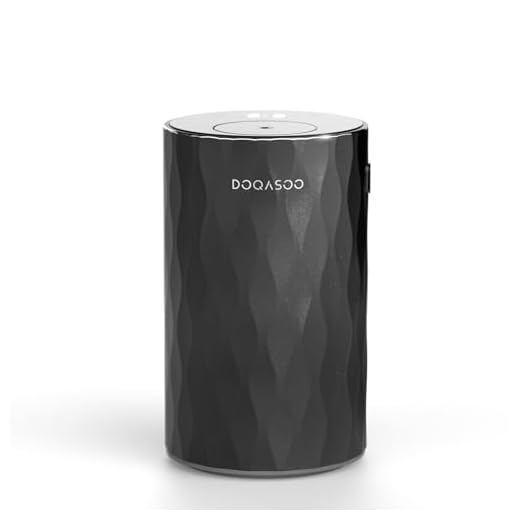
- How It Works (The Simple Bit): This one uses no water. It works like a perfume atomiser. You attach the essential oil bottle directly to the device. A small, powerful air pump creates a vacuum that pulls the oil up through a tiny tube and blasts it into a fine vapour of pure oil.
- The Good Stuff (Pros):
- The Strongest Scent: This is the big one. It gives you 100% pure, undiluted essential oil in the air. The therapeutic kick is instant and powerful.
- No Water, No Faff: You don’t have to worry about topping up water or mouldy tanks.
- The Not-So-Good Stuff (Cons):
- Uses Oil Fast: Because it’s so powerful, it gobbles up your expensive essential oils.
- It’s Loud: That little air pump makes a noticeable buzzing or humming sound. It’s definitely not “whisper-quiet” and not ideal for a bedroom.
- More Expensive: These are a bigger investment, often costing £80 – £150.
- Needs Careful Cleaning: The little glass tubes can get clogged with sticky oil residue and need cleaning with rubbing alcohol.
Best for: Serious aromatherapy fans who want the most potent therapeutic benefit and don’t mind the noise or the running cost.
3. Heat Diffusers (The Old-School Way)
These are simpler and often cheaper. They range from the classic ceramic bowl with a tea light underneath to electric plug-in wall units.
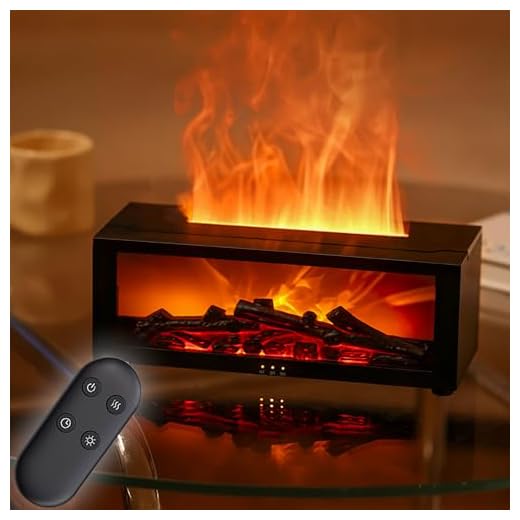
- How It Works (The Simple Bit): It gently warms the essential oil (either on its own or in a little water) to make it evaporate and spread around the room.
- The Good Stuff (Pros):
- Silent: No moving parts, no water, just gentle heat.
- Cheap: A simple plug-in or ceramic burner can cost as little as a fiver.
- The Not-So-Good Stuff (Cons):
- Heat Can Change the Oil: This is the big downside for purists. Heating an essential oil can change its chemical structure, potentially reducing its therapeutic benefits.
- Less Effective: The scent doesn’t travel as far or as evenly as with a mist-based diffuser.
- Safety Risk: The ones with a naked flame (tea light) are an obvious fire hazard. Even electric ones get hot.
Best for: A cheap and silent way to get a pleasant smell in a small room, but not the best for serious relaxation therapy.
4. Evaporative Diffusers (The Fan-Powered One)
These are less common but you’ll see them, especially in small, portable, or car-friendly models.
- How It Works (The Simple Bit): You put a few drops of oil onto a pad or filter. A small, quiet fan blows air across the pad, causing the oil to evaporate and spread into the air.
- The Good Stuff (Pros):
- Simple & Portable: Often battery-powered or USB, making them great for your desk, car, or for taking on holiday.
- The Not-So-Good Stuff (Cons):
- Noisy Fan: The fan, while small, can be annoying in a quiet room.
- Pads Need Replacing: The filter pads get gunked up and need to be regularly replaced.
- Uneven Diffusion: The lighter bits of the oil evaporate first, so you don’t get the full, balanced scent.
Best for: Travel, your car, or your desk at work. A “top-up” diffuser, not a main home one.
Quick Comparison Table
| Feature | Ultrasonic | Nebulising | Heat | Evaporative |
|---|---|---|---|---|
| How it Works | Vibrating disc & water mist | Air pump & pure oil | Gentle warmth | Fan & pad |
| Scent Strength | Medium | Very High | Low | Low-to-Medium |
| Oil Used | Low (3-5 drops) | Very High | Low | Medium |
| Noise Level | Very Quiet (gurgle) | Loud (buzz) | Silent | Quiet (fan hum) |
| Maintenance | High (weekly clean) | Medium (alcohol clean) | Low | Medium (replace pads) |
| Best For… | General Use, Bedrooms | Therapy, Large Rooms | Small Rooms, Budget | Travel, Desk |
Part 4: Your Perfect Match – How to Choose the Right Diffuser for You
Okay, you know the types. Now, how do you pick from the hundreds on the shelf at Oliver Bonas or on Amazon? Ask yourself these questions.
What’s the Size of Your Room?
This is the most important question.
- Small Room (Bedroom, Home Office): An ultrasonic diffuser is perfect. You don’t need massive power, and the quiet operation is key. A heat diffuser could also work.
- Large Room (Open-Plan Living Room/Kitchen): You need power. A nebulising diffuser is the best for filling a big space. If you prefer an ultrasonic, look for one with a large water tank (e.g., 300-500ml) and a high “mist output.”
How Much Faff Are You Willing to Put Up With? (Be Honest!)
There’s no point buying a high-maintenance diffuser if you know you’ll never clean it.
- “I want zero faff”: A nebuliser has less frequent cleaning, but it’s more fiddly. A simple heat diffuser is the easiest to wipe clean.
- “I’m happy to clean it once a week”: An ultrasonic is your best bet. It’s a simple 5-minute job with a bit of kitchen roll and maybe some white vinegar.
What’s Your Budget?
- Under £30: You’re in the realm of simple heat diffusers or basic, small-capacity ultrasonic models from less-known brands. They’ll do the job.
- £40 – £80: This is the sweet spot. You can get a high-quality, reliable ultrasonic diffuser from a great brand (like Tisserand or Muji) or even a basic nebuliser.
- £80 – £150+: You’re now in the “premium” category. This gets you the designer ultrasonic models (like Neom’s Wellbeing Pod or The White Company’s ceramic versions) or a top-end nebulising diffuser. You’re paying for build quality, aesthetics, and brand name.
Are You a Light Sleeper?
If this is for your bedroom, noise is everything.
- A nebuliser is a definite no. The pump will drive you mad.
- An ultrasonic is your best friend. The gentle gurgling sound is barely noticeable.
- A heat diffuser is the only type that is 100% silent.
Do You Like All the Bells and Whistles?
Modern diffusers come with a lot of extras.
- LED Lights: Most ultrasonics have these. They can cycle through colours or be fixed on one. Top tip: Make sure you can turn the light completely off. A glowing blue light is the last thing you want when you’re trying to sleep.
- Timers: Genuinely useful. You can set it to run for 1, 3, or 6 hours and then switch off automatically.
- Intermittent Mist: A great feature. The diffuser mists for 30 seconds, then pauses for 30 seconds. This stops you from getting used to the smell (see “Common Grumbles”) and makes your oil last longer.
- Smart Features: Some high-end models connect to Wi-Fi so you can control them from your phone. A bit gimmicky, but you might like it.
Aesthetics: Does It Match Your Decor?
Let’s be real, this thing is going to be sitting on your shelf. You don’t want an ugly plastic blob.
- The Scandi/Minimalist Look: Look at Muji or brands using light wood and white plastic.
- The “Spa-at-Home” Look: Premium brands like Neom and The White Company excel here, often using ceramic or sleek metal finishes.
- The “Boho/Natural” Look: You can find lovely diffusers made from bamboo, dark wood, or even frosted glass.
Part 5: The All-Important Oil – Choosing Your Lavender
You can buy the best, most expensive diffuser in the world, but if you put cheap, nasty oil in it, you’re wasting your money. This part is crucial.
Not All Lavender is Created Equal
You’ll see a few different types. For relaxation, you want True Lavender (Lavandula angustifolia). This is the one with the high levels of those calming chemicals we talked about.
You might also see:
- Lavandin (Lavandula x intermedia): A hybrid. It smells nice and is cheaper, but it has higher camphor levels, which can actually be stimulating. It’s better for cleaning products, not for chilling out.
- Spike Lavender (Lavandula latifolia): Also high in camphor. Smells more medicinal, like eucalyptus. Again, not the one for sleep.
Check the bottle! It must say Lavandula angustifolia (or “English Lavender”).
Essential Oil vs. Fragrance Oil: A VERY Big Warning
This is the biggest mistake people make.
- Essential Oil: 100% natural, steam-distilled directly from the lavender plant. This is the only thing you should ever put in your diffuser.
- Fragrance Oil (or “Scented Oil”): This is synthetic, man-made perfume. It’s made from chemicals in a lab to smell like lavender. It has zero therapeutic benefits and can gunk up your diffuser. It’s the difference between drinking fresh orange juice and drinking orangeade.
If the bottle is very cheap and just says “Lavender Oil,” be suspicious.
Spotting a Quality Oil: A Sniff Test
- The Bottle: It should always be in a dark-coloured glass bottle (amber or blue) to protect the oil from sunlight, which breaks it down.
- The Label: It should clearly state:
- “100% Pure Essential Oil”
- The botanical name: Lavandula angustifolia
- Ideally, the country of origin (e.g., France, Bulgaria, or the UK).
- The Price: Good essential oil is not cheap. It takes a huge amount of lavender to make one tiny bottle. If you see 10ml for £1.50, it’s almost certainly fake or heavily diluted. Expect to pay £8 – £15 for a good 10ml bottle.
Great British Lavender: Where to Buy
You don’t have to look far. The UK has some of the best aromatherapy brands in the world.
- Tisserand: A brilliant, reliable, and accessible brand. You can find them in Boots and Holland & Barrett. Their lavender is top-notch.
- Neom Organics: A luxury British brand. Their “Perfect Night’s Sleep” blend (which features lavender) is famous for a reason.
- Aromatherapy Associates: The height of luxury. Their “Deep Relax” blend is iconic.
- Local Farms: Look for British-grown lavender from farms like Cotswold Lavender or Norfolk Lavender. You’re supporting a local industry and getting a fantastic product.
Part 6: You’ve Got Your Kit – Now What? (A Practical Guide)
You’ve bought your beautiful new diffuser and a bottle of high-quality Lavandula angustifolia. You’re ready to relax. Here’s how to do it right.
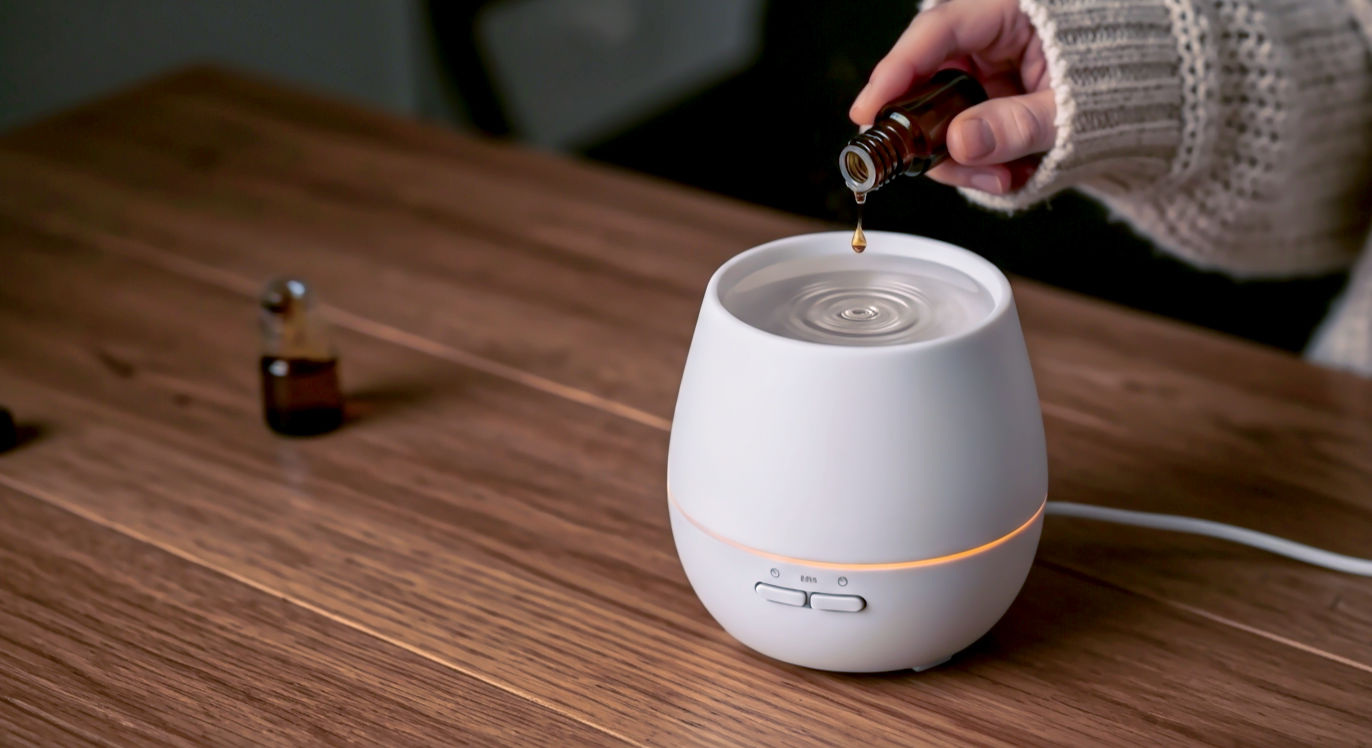
How to Use Your Diffuser (The Right Way)
- Placement: Put it on a flat, stable surface where it won’t be easily knocked over. Don’t place it on top of other electrical items or on a fancy wooden table without a coaster, just in case of spills.
- Water (for Ultrasonics): Use clean, room-temperature tap water. Fill it up to the “MAX” line, and never overfill it. If you live in a very hard water area, filtered or distilled water can help reduce limescale build-up.
- Oil: Add 3 to 5 drops of lavender oil to the water. That’s it. It’s tempting to add 10 drops, thinking it’ll be “more relaxing.” It won’t. It’ll just be overpowering and give you a headache. Less is more.
- Timing: Don’t leave it running all night. Your body gets the benefits within the first 30-60 minutes. After that, you’re just getting used to the smell and wasting oil. Use the timer function. Set it for 1 hour as you’re getting into bed, or for an hour when you get home from work.
How to Clean Your Diffuser (The Boring But Vital Bit)
If you don’t clean your ultrasonic diffuser, it will become a mini-swamp of old oil gunk, limescale, and potentially mould. This is not relaxing.
- After Every Use (Quick Wipe): Unplug it. Empty any leftover water. Wipe the inside of the tank with a bit of kitchen roll.
- Once a Week (Deep Clean):
- Unplug and empty it.
- Pour a tablespoon of white vinegar and a bit of water into the tank. Let it sit for 15-20 minutes. (This dissolves limescale).
- Gently use a cotton bud to clean the little ultrasonic disc at the bottom. Be very gentle with this bit.
- Rinse it all out thoroughly with clean water.
- Wipe it dry. You’re good to go.
The Art of “Scent-Scaping”
Once you’re a lavender pro, you can get creative. Lavender blends beautifully with other relaxing oils. Try adding:
- 1 drop of Chamomile: For a sleepy, herbal, “cup of tea” vibe.
- 1 drop of Bergamot: For a “calm but focused” feel. Great for a home office.
- 1 drop of Frankincense: For a deep, meditative, yoga-studio atmosphere.
Part 7: The Safety Chat – Using Diffusers Responsibly
A diffuser is a brilliant tool, but it’s not a toy.
A Word of Warning: Is It Always Relaxing?
Sometimes, too much of a good thing is bad. If you’re running your diffuser for hours on end, you might experience:
- Headaches
- Nausea
- Sensory overload (where your brain just feels “full”)
If you feel any of this, turn it off, open a window, and drink some water. Next time, use less oil or run it for a shorter time.
Diffusers and Your Furry Mates (Cats & Dogs)
Right, listen up. This is a crucial one for us as a nation of animal lovers.
Cats: Your cat’s liver is different from yours. It’s missing a specific enzyme (glucuronyl transferase) that helps process compounds found in many essential oils, including lavender. This means the compounds can build up in their system and become toxic over time.
- Symptoms of toxicity can include drooling, wobbliness, breathing trouble, or vomiting.
- What to do:
- NEVER use a diffuser in a small, closed room where your cat is “trapped.”
- ALWAYS diffuse in a large, well-ventilated room (e.g., leave the door open) so your cat can easily leave if the smell bothers them.
- Stick to short bursts (e.g., 30-60 minutes) instead of all-day diffusion.
- If your cat has asthma, don’t use a diffuser at all.
- If you’re worried, chat to your vet.
Dogs: Dogs are generally less sensitive than cats, but their sense of smell is thousands of times better than ours. What you think is a “gentle” scent of lavender might be a nose-punching, overwhelming fog for your dog.
- What to do: Same as with cats. Ensure good ventilation, always give them an “escape route” out of the room, and watch for any signs of irritation, like sneezing or watery eyes.
A Note for Babies and Children
The jury is out on using diffusers around very young babies (under 6 months). Their respiratory systems are still developing. It’s best to err on the side of caution and avoid it.
For older children, a diffuser in a bedroom for 30 minutes before bed can be lovely. Just use less oil (1-2 drops is plenty) and make sure the room is ventilated.
Part 8: Common Grumbles and How to Fix Them
“Why can’t I smell it anymore?” This is called olfactory fatigue. Your nose has simply got used to the smell and has started filtering it out. It’s the same reason you can’t smell your own perfume after 20 minutes. The diffuser is still working, your brain is just ignoring it. This is why intermittent settings and timers are so useful!
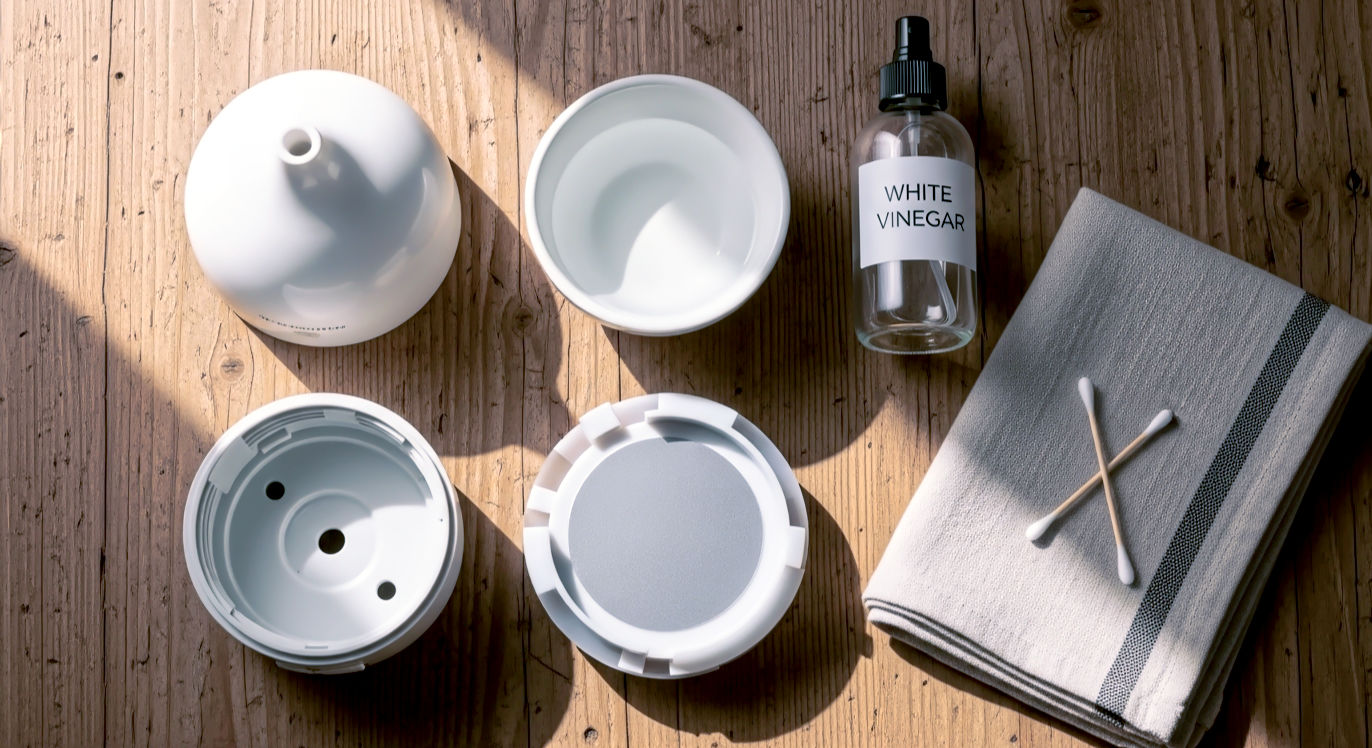
“My diffuser is making a loud gurgling/buzzing noise.”
- If it’s an ultrasonic, a gentle gurgle is normal. That’s the water moving. If it’s a loud buzz, the water level might be too low, or the ultrasonic plate needs a clean.
- If it’s a nebuliser, a loud buzz is normal. That’s the sound of the air pump.
“It just stopped working!” 99% of the time, this is a cleaning issue.
- Unplug it.
- Empty it.
- Check that the ultrasonic plate at the bottom isn’t covered in limescale or oil gunk.
- Give it the vinegar-and-cotton-bud clean we talked about. This usually fixes it.
Part 9: The Future of Relaxation?
This tech isn’t standing still. We’re already seeing:
- Smart Diffusers: You can schedule your diffuser to turn on 30 minutes before your alarm, so you wake up to a gentle, energising scent. Or link it to your smart home system.
- Sustainability: We’re seeing more diffusers made from sustainable materials like bamboo, recycled glass, or ceramic. There’s also a bigger push for “waterless” tech (like nebulisers) that doesn’t use water and “heatless” tech that doesn’t use electricity.
Conclusion: Your Home, Your Sanctuary
Choosing a lavender diffuser isn’t about buying the most expensive, all-singing, all-dancing gadget. It’s about finding the right tool for your specific space, your lifestyle, and your relaxation needs.
- For most of us in the UK, a good ultrasonic diffuser is the perfect blend of price, performance, and quiet operation.
- For the aromatherapy purist, a nebuliser offers an unmatched, powerful experience.
Whichever you choose, by pairing it with a high-quality, 100% pure Lavandula angustifolia essential oil, you’re not just making your house smell nice. You’re creating a little pocket of calm. You’re actively carving out a sanctuary from the noise of the outside world.
And frankly, we all deserve a bit more of that.
Further Reading & Authoritative Resources
For those who wish to dive even deeper, here are some of the most respected resources in this field:
- Tisserand Institute: Founded by Robert Tisserand, a world-leading expert in essential oil safety and aromatherapy.
- Aromatherapy Associates: A pioneering British brand with a wealth of expertise on essential oil blending and benefits.
- The Soil Association: The UK’s leading organic certifier. Look for their logo on essential oils to guarantee they are organic and free from pesticides.
- The Blue Cross for Pets: Provides excellent, balanced advice on essential oils and pet safety in the UK.
- John Lewis & Partners: Their buying guides often provide a great overview of the types of diffusers available in the UK market.

